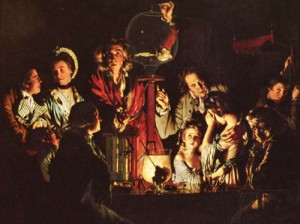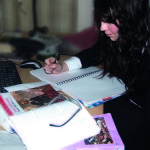Women and femininity in the history of science
Table of Contents
Women have always participated in scientific endeavour, even before the term ‘scientist’ was invented. (The term ‘scientist’ is usually attributed to William Whewell, Cambridge academic, who used it in its modern sense in 1841, but some scholars say it originated a few years before this.) However, femininity and science did not sit happily together in Western culture, and the masculine colouring of science reflected not just that more men did science, but that science itself was perceived as an inherently masculine enterprise.
The idea that science and mathematics were inappropriate or ‘too hard’ for women, and even ‘at odds’ with true femininity, can be traced back (at the very least) to the origins of modern science and the birth of the Royal Society in the seventeenth century. Then ‘femininity’ became the antithesis of the new, virile, experimental science of Newton and his colleagues who wanted to break from the passive, contemplative investigative style of traditional ‘natural philosophy’ (the earlier term for ‘science’). This split, which distanced women from the new experimental science, was made even wider by the tradition of Nature being personified in only female form (for example, ‘Mother Nature’). The male scientists made mother nature their object of investigation, and also characterised her as a ‘female muse’ who could seduce and trick them, but if tamed would also allow them to ‘penetrate her secrets’. This whole set-up cast the feminine as the passive, subject of enquiry and the male as the virile, active investigator; a duality which only added to the dissonance between femininity and science.
Women scientists

Portrait of Madame Lavoisier and her husband Antroine (c1788). Born Marie-Anne Pierelle Paulze, Madame Lavoisier was an accomplished scientist in her own right and has been called ‘the mother of modern chemistry’. Note the gendered representations in this portrait. Marie-Anne is posed as the doting wife while her husband is pictured at work with the paraphernalia of chemical experimentation.
Despite this, there were many women scientists—astronomers, chemists, botanists mathematicians and so on—who contributed to science in the seventeenth and eighteenth centuries. (For biographies search the HerStoria web’s ‘Discover’ pages; entries are added regularly). Indeed, the first woman to have contributed an article to the Philosophical Transactions of the Royal Society is recorded as Ann Whitfield who wrote on the effects of a thunderstorm in Rickmansworth, Hertfordshire, in 1760. A few years later, at the end of the eighteenth century, astronomer Caroline Herschel published several papers, including one detailing the discovery of three nebulae. Women as a rule did not receive an education equivalent to their brothers, instead being schooled in accomplishments and household duties rather than intellectual subjects, and this put them at a disadvantage when it came to scientific work. In the eighteenth century, privileged women who did acquire great learning were often referred to disparagingly as ‘bluestockings’.
Science closes its doors to women
In the early nineteenth century, women with scientific interests could often indulge them as science grew in popularity and status and as institutions, such as the new University of London, opened some of their science their lectures to women. However, this was to prove short-lived. From the mid-nineteenth century onwards, as science sought to professionalise itself and move away from any hint of amateurism, institutions sought to become more exclusive; typically, a first step to achieving serious scientific status was a closing of the doors to women. In particular, access of women to the membership became a battleground for learned scientific societies vying with each other for status: the exclusion of women was a powerful way to signal a society’s elite status. When the Royal Geographic Society debated the possibility of female fellows in 1892-3 an angry dispute between council members was conducted via the letters page of The Times. The Royal Astronomical Society confirmed its refusal to admit women in 1892 too, when three women were put forward as candidates. This exclusivity encouraged the establishment in 1890 of the rival British Astronomical Association which welcomed women and other ‘amateurs’ into its ranks. This opportunity was important for women as astronomy was an activity that had remained more accessible to them. When other sciences moved from the home to the university, female stargazers could still work at astronomy by studying the night sky from a modest home observatory, or even away on a field trip. The Royal Astronomical Society finally admitted women in 1915.
As the twentieth century dawned, the issue of women became a headache for several learned societies when modernisers from the male membership put forward female candidates for election, reflecting the fact that more women where gaining a scientific education as the universities began opening up to them. The Entomological Society which, according to science journal Nature at the time, was ‘formally so exclusive that ladies who contributed papers were not even admitted to be present when they were read’ elected its first woman member in 1904. Just two years earlier, in 1902, the first woman was nominated for election to that most august of scientific institutions, the Royal Society. She was the physicist and electrical engineer Hertha Ayrton. This nomination caused great division; those supporting her nomination argued against traditionalists on the council who warned that admitting women risked trivialising the Society; this argument won the day and the Royal Society held fast to an all-male fellowship for the next forty years. It was to be 1945 when the first women were admitted as fellows (crystallographer Kathleen Lonsdale and biochemist Marjory Stephenson) and the 2008 gender profile of the Royal Society reveals that today of 1317 fellows, just 66 or 5% are women.
The science of sexual difference

This is Joseph Wright of Derby’s celebrated painting An experiment on a bird in the Air Pump (c 1768) which depicts an 18C scientist/showman demonstrating the formation of a vacuum which kills the bird. Note the audience consists of men, women and children.
The final decades of the nineteenth century was also a time when science itself began looking at the differences between men and women to decide which activities and roles were best suited to each sex. After Darwin, the evolution of man was a hot topic and scientists explained that women’s brains had not evolved to the same level as men’s. Natural selection had not promoted the development of women’s rational capacities; whereas men developed their brains in the competition with other males for mates, women were selected more for their caring, maternal qualities and for their intuition. Darwinist scientists and medical men doubted whether women, who were designed by evolution to be emotional and partial, with a tendency to shift attention and achieve only surface understandings, could be trusted to do science. Women were competent in their ‘natural’ role as wives and mothers, but they were intellectually and temperamentally unsuited to scientific work; they were just too damn emotional and could not be trusted with evidence. (When then President of Harvard University, Larry H. Summers, made his infamous speech in 2005 asserting that innate differences between men and women may be one reason for women’s lack of success in science, he tapped in to a long history of such views.)
But of even more concern to the nineteenth-century scientific and medical community was that if you subjected women to hard intellectual labour, their health would inevitably suffer. The new women’s colleges opening up in the 1880s and 1890s were wary of provoking criticism from opponents who argued that women jeopardised their well-being by following a programme of education similar to men’s. Women risked nervous breakdown (including anorexia scholastica, a disease recently identified), loss of fertility, loss of womanly beauty and, most important of all, a decrease in marriageabilty. Domesticity and motherhood were the best pursuits for women and any female with ‘manly’ scientific or intellectual pursuits was not only misguided, she was unnatural.
Despite this of course, women carried on doing science and found spaces for their passion in whatever place they could. Many of them have only been recognised in the last few years as their contributions to science had been hidden from history, often because they collaborated with a husband or male relative or friend who alone received credit for joint work. (Examples include astronomers William and Margaret Huggins and Annie and Edward Maunder, botanists Caroline and Dukinfield Henry Scott, and mathematicians Grace Chisholm and William Henry Young).
Women’s place in science
As the institutionalisation and professionalization of science carried on and strengthened in the first two decades of the twentieth century, more women did gain entry to science, but mostly they were segregated in to limited roles that made use of their special ‘feminine skills’. These jobs were typically low-paid, low-level technician and assistant appointments which worked to reinforce the dominant gender hierarchies in science, not to challenge them. They often required a docile attitude, great patience and painstaking attention to repetitive detail. Even as late as the early 1980s recruitment advertisements for light bulb assembly lines sent out the message ‘for women only’ by calling for ‘nimble fingers’ and likening the qualities needed as akin to ‘knitting’. These jobs for women expanded in the UK during the World Wars when women were needed to replace men away on active service. It was during WW1 that women first gained admission to the National Physical Laboratory where they were employed in the Metrology Department to undertake gauge-testing, an important aspect of the munitions industry. By the summer of 1917 there were ninety nine women out of 420 staff in the department.
Women still have not achieved the same levels of participation and success as men in science, mathematics and engineering. The continuing ambivalence shown by girls as to whether to take up a career in these areas is still wrought with cultural factors: they are continuing to see scientific jobs as ‘unfeminine’, a perception that organisations such as WISE (Women into Science, Engineering and Construction) are working with some success to dispel. Their mission may be helped by the increasing number of representations of female scientists in films and on our TV screens these days—although these glamorous women, hair always in place, lipsticks at the ready and male admirers waiting in line, may be placing another near impossible demand on female scientists. But that’s another story… .










Leave a Reply